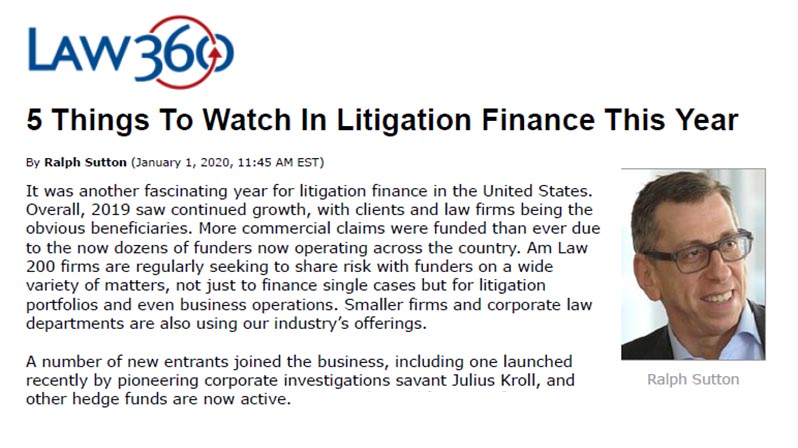January 1, 2020
Law360 (January 1, 2020)
It was another fascinating year for litigation finance in the United States. Overall, 2019 saw continued growth, with clients and law firms being the obvious beneficiaries. More commercial claims were funded than ever due to the now dozens of funders now operating across the country. AmLaw 200 firms are regularly seeking to share risk with funders on a wide variety of matters, not just to finance single cases but for litigation portfolios and even business operations. Smaller firms and corporate law departments are also using our industry’s offerings.
A number of new entrants joined the business, including one launched recently by pioneering corporate investigations savant Julius Kroll, and other hedge funds are now active. Despite the proliferation of new players, I don’t think there is too much money chasing too few deals — if
anything the added capital has helped expand the marketplace and fuel new areas of focus and investment.
Two prominent funders found themselves at the center of unwanted attention. U.K.-based Vannin, unable to raise additional needed capital, was absorbed by its main investor, Fortress. Meanwhile, a short seller launched an aggressive attack against Burford Capital, the largest publicly traded funder, causing a steep drop in market value.
Here I offer five predictions and assorted observations for the coming year in dispute funding. I also rate last year’s predictions and warmly welcome feedback.
1. Trust Matters, Again
Turns out that the single most important factor for clients and law firms choosing a funder is trust. How do we know? Validity and ALM Media launched a bi-annual survey of nearly 350 law firm and corporate lawyers to test their actual experience with funding and find out what mattered to clients. With new players entering the market every day, and perhaps because of that, trust matters to clients more than ever.
So, let’s unpack trust for a minute. What does it refer to in the funding context? How is it built?
First, it means that funders actually have capital to fund deals when they say they do, and don’t operate in reality as brokers, raising funds deal by deal.
Second, clients will trust financiers who treat clients and firms fairly in returns and other key terms. Many funders target 50% to 60% of case proceeds to clients in single cases (and a
similar metric for law firm portfolios).
Third, trust is built during due diligence by collaborating with counsel to bring strategy and smarts — not just money — to bear on a legal problem. This is far easier to do when your
investment team consists of seasoned trial lawyers.
Finally, trust is built by the funding process itself. Funders that impose onerous due diligence and protracted negotiations on clients, rather than making these necessary steps seamless and efficient — blow up trust.
As litigation finance players become increasingly known and differentiated (more on this in a minute), law firms and clients will begin to demand a better, more user-friendly experience. One deal at a time. Reputations get made this way.
2. Greater Transparency and Accountability
Two trends will contribute in the coming year to greater transparency and accountability. Fundamentally, funders with strong cultures who create value for clients will be rewarded and recognized.
Publicly traded finance companies are already better understood. But what about private funding entities? Here’s where the trends kick in. A recent guide to funders published by Westfleet begins the process. A summary of private entities and their capital parameters begins to makes the world more comprehensible to clients and firms. Other refinements are likely, and can be expected to track number of deals done and success, and thereby separate best-in-class managers from others who may lack much funding experience.
Second, headlines related to public founders are prompting many private funders to imagine an association to self-regulate the industry. Why this hasn’t happened to date probably has much to do with the early stages of the industry participants: litigation finance professionals are busy serving clients and deploying their capital. But what is abundantly clear is that the time has come. Indeed, I expected that a self-regulating body would come into being last year, perhaps modeled on the U.K.’s successful ALF. But that was premature.
3. Funding Expands Its Geographic Reach
Currently, seven funders operate in Chicago alone, with over 35 full time professionals. More than you imagined? Nearly all the other U.S.-founded funders are based in New York, where much of the industry’s capital is also based. My third prediction is that we will begin this year to see dedicated full-service offices not only in Houston, Dallas, LA and San Francisco, where a few have offices, but also in D.C., Miami, Boston and San Diego. Why? Because many excellent firms are based in these cities and funders facing intense competition will seek out less crowded fishing holes.
4. Pricing Begins to Segment by Deal Size
As larger firms and corporate clients begin to see the utility of transferring risk to funders, the size of deals will enlarge, particularly portfolio deals. And as our asset class and its uncorrelated nature becomes better understood, institutional capital (hedge funds and family offices) will increasingly enter the market at the top end. Their return targets are typically lower but to “move their needle” the transactions will often need to be larger than $20 million. To the extent the deals offer some kind of diversification they will do fine. If not, we should expect to see losses and perhaps some blow-ups.
For the rest of the market, prices are stable. As a full understanding of the risks inherent in highly unpredictable litigation outcomes becomes bracing, with occasional losses — like a coldwater plunge — pricing may even move up.
5. Secondary Market Growth
I think we’ll see tremendous growth in the secondary market this year. Secondary transactions are similar to re-insurance, where bankers are tasked with re-selling to new investors a portion of risk already taken by a funder on a single case or a pool of cases. This monetization of funded cases offers the funder a chance to de-risk their investment in whole or in part. Such transactions can also help funders mark their pending investments higher. This helps with the next capital raise. A few folks are active in this space, but others are sure to follow.
Bonus Round
I also expect — as I foresaw last year — no change in the federal mandatory disclosure rules.
Why? Because the committee overseeing rule changes is quite deliberate and cautious. There are also really no compelling reason for the committee to revise finely-calibrated rules of relevancy and proportionality, nor time-honored principles of privacy and fairness that apply equally to defendants (how large a reserve a company takes for potential liability or how it funds its own litigation) and to plaintiffs (the fact and size of a contingency fee arrangement).
Grading Last Year’s Predictions
Last year, I made five industry predictions heading into this year. First, I foresaw the continued entry of a significant number of new funders into the market. On that projection, score one point (a gimme). Second, I thought I could see the green shoots of defenses funding beginning to emerge. Score a zero, as this aspect of funding awaits the development of new products and more education of in-house counsel as to the benefits of risk sharing. Third, I thought the federal committee overseeing amendments to the rules of civil procedure would probably study the situation further and not amend the rules. I was right and score a point. On the formation of a self-regulating association, a zero. Finally, it seemed likely that the debate regarding portfolio financing would remain active, and this adds another point. So, I nailed only three out of five. There are no crystal balls.
As 2020 arrives, we may see new products and initiatives we can’t imagine yet. But one thing is clear: This industry is well past its earliest stage and is entering a very active growth spurt. All of which benefits clients and law firms. And may soon benefit corporate law departments.
Watch this space.

